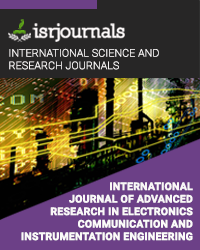gps tracking and energy saving system in android mobile environments.
D.Venkateshwaran,V.Kumaran
Published in International Journal of Advanced Research in Electronics, Communication & Instrumentation Engineering and Development
ISSN: 2347 -7210 Impact Factor:1.9 Volume:1 Issue:1 Year: 08 November,2013 Pages:37-44

Abstract
We consider a set O of objects, a query point q, and a positive value r. We use dist(o,q) to denote the distance between an object o e O and the query q. A distance-based range query returns every object o e O that lies within distance r of the query location q, i.e., every object such that dist(o,q) <= r. Our main focus in this paper is on euclidean distance-based range queries. Since the search space around the query is a circle in this case, such queries are also called circular range queries. We also consider the case when distance (o,q) is the network distance between o and q (e.g., queries moving in a road network). Another variation of the range query, which we term “rectangular range query” (also called window query), returns the objects that lie within a rectangle around the query location. Distancebased range queries and rectangular range queries are inherently different and have different applications. When clear by context, we use the term range query to refer to the distance-based range queries. Due to availability of inexpensive position locators, cheap network bandwidth and the mobile device with high computation and storage capabilities, location-based services are gaining increasing popularity.
Kewords
SWT, DWT, IDWT, LL, ImageResolution Synthesis.
Reference
[1] L. Yi-bo, X. Hong, and Z. Sen-yue,“The wrinkle generation method for facial reconstruction based on extraction of partition wrinkle line features and fractal interpolation,” in Proc. 4th Int. Conf. Image Graph., Aug. 22–24, 2007, pp. 933–937. [2] Y. Rener, J. Wei, and C. Ken, “Downsample- based multiple description coding and postprocessing of decoding,”inProc. 27th Chinese Control Conf., Jul. 16–18, 2008, pp. 253–256. [3] H. Demirel, Anbarjafari, and S. Izadpanahi, “Improved motionbased localized super resolution technique using discrete wavelet transform for low resolution video enhancement,” in Proc. 17th Eur. Signal Process. Conf., Glasgow, Scotland, Aug. 2009, pp. 1097–1101. [4] Y. Piao, I. Shin, and H. W. Park, “Image resolution enhancement using inter-subband correlation in wavelet domain,” in Proc. Int. Conf. Image Process., 2007, vol. 1, pp. I-445–448. [5] H. Demirel and G. Anbarjafari, “Satellite image resolution enhancement using complex wavelet transform,” IEEE Geoscience and Remote Sensing Letter, vol. 7, no. 1, pp. 123–126, Jan. 2010. [6] C. Atkins, C. A. Bouman, and J. P. Allebach, “Optimal image scaling using image pixel classification,” in Procedingds. Int. Conf. Image Process., Oct. 7–10, 2001, vol. 3, pp. 864–867. [7] W. K. Carey, D. B. Chuang, and S. S. Hemami,“Regularity-preserving decimated image interpolation,” IEEE Trans. Image Process., vol. 8, no. 9, pp. 1295–1297, Sep. 1999. [8] K. Kinebuchi, D. D. Muresan, and R. G. Baraniuk, “Waveletbased statistical signal processing using hidden Markov models,” in Proc. Int. Conf. Acoust., Speech, Signal Process., 2001, vol. 3, pp. 7–11. [9] G. Anbarjafari and H. Demirel, “Image super resolution based on interpolation of wavelet domain high frequency subbands and the spatial domain input image,” ETRI J., vol. 32, no. 3, pp. 390–394, Jun. 2010.

